
среда, 30 июня 2010 г.
вторник, 29 июня 2010 г.
среда, 9 июня 2010 г.
Allergies
Your eyes itch, your nose is running, you're sneezing, and you're covered in hives. It's allergy season again, and all you want to do is curl up into a ball of misery.
There has to be something you can do to feel better. After all, doctors seem to have a cure for everything, right? Not for allergies. But there are ways to relieve allergy symptoms or avoid getting the symptoms, even though you can't actually get rid of the allergies themselves.
What Are Allergies?
Allergies are abnormal immune system reactions to things that are typically harmless to most people. When you're allergic to something, your immune system mistakenly believes that this substance is harmful to your body. (Substances that cause allergic reactions, such as certain foods, dust, plant pollen, or medicines, are known as allergens.)

In an attempt to protect the body, the immune system produces IgE antibodies to that allergen. Those antibodies then cause certain cells in the body to release chemicals into the bloodstream, one of which is histamine (pronounced: his-tuh-meen).
The histamine then acts on the eyes, nose, throat, lungs, skin, or gastrointestinal tract and causes the symptoms of the allergic reaction. Future exposure to that same allergen will trigger this antibody response again. This means that every time you come into contact with that allergen, you'll have an allergic reaction.
Allergic reactions can be mild, like a runny nose, or they can be severe, like difficulty breathing. An asthma attack, for example, is often an allergic reaction to something that is breathed into the lungs by a person who is susceptible.
Some types of allergies produce multiple symptoms, and in rare cases, an allergic reaction can become very severe — this severe reaction is called anaphylaxis (pronounced: an-uh-fuh-lak-sis). Signs of anaphylaxis include difficulty breathing, difficulty swallowing, swelling of the lips, tongue, and throat or other parts of the body, and dizziness or loss of consciousness.
Anaphylaxis usually occurs minutes after exposure to a triggering substance, such as a peanut, but some reactions might be delayed by as long as 4 hours. Luckily, anaphylactic reactions don't occur often and can be treated successfully if proper medical procedures are followed.
Why Do People Get Allergies?
The tendency to develop allergies is often hereditary, which means it can be passed down through your genes. (Thanks a lot, Mom and Dad!) However, just because a parent or sibling has allergies doesn't mean you will definitely get them, too. A person usually doesn't inherit a particular allergy, just the likelihood of having allergies.
What Things Are People Are Allergic to?
Some of the most common allergens are:
Foods. Food allergies are most common in infants and often go away as people get older. Although some food allergies can be serious, many simply cause annoying symptoms like an itchy rash, a stuffy nose, and diarrhea. The foods that people are most commonly allergic to are milk and other dairy products, eggs, wheat, soy, peanuts and tree nuts, and seafood.
Insect bites and stings. The venom (poison) in insect bites and stings can cause allergic reactions, and can be severe and even cause an anaphylactic reaction in some people.

Airborne particles. Often called environmental allergens, these are the most common allergens. Examples of airborne particles that can cause allergies are dust mites (tiny bugs that live in house dust); mold spores; animal dander (flakes of scaly, dried skin, and dried saliva from your pets); and pollen from grass, ragweed, and trees.
Medicines. Antibiotics — medications used to treat infections — are the most common type of medicines that cause allergic reactions. Many other medicines, including over-the-counter medications (those you can buy without a prescription), also can cause allergic-type reactions.
Chemicals. Some cosmetics or laundry detergents can make people break out in an itchy rash (hives). Usually, this is because someone has a reaction to the chemicals in these products. Dyes, household cleaners, and pesticides used on lawns or plants also can cause allergic reactions in some people.
How Do Doctors Diagnose and Treat Allergies?
If your family doctor suspects you might have an allergy, he or she might refer you to an allergist (a doctor who specializes in allergy treatment) for further testing. The allergist will ask you about your own allergy symptoms (such as how often they occur and when) and about whether any family members have allergies. The allergist also will perform tests to confirm an allergy — these will depend on the type of allergy someone has and may include a skin test or blood test.
The most complete way to avoid allergic reactions is to stay away from the substances that cause them (called avoidance). Doctors can also treat some allergies using medications and allergy shots.
Avoidance
In some cases, like food allergies, avoiding the allergen is a life-saving necessity. That's because, unlike allergies to airborne particles that can be treated with shots or medications, the only way to treat food allergies is to avoid the allergen entirely. For example, people who are allergic to peanuts should avoid not only peanuts, but also any food that might contain even tiny traces of them.
Avoidance can help protect people against non-food or chemical allergens, too. In fact, for some people, eliminating exposure to an allergen is enough to prevent allergy symptoms and they don't need to take medicines or go through other allergy treatments.
Here are some things that can help you avoid airborne allergens:
- Keep family pets out of certain rooms, like your bedroom, and bathe them if necessary.
- Remove carpets or rugs from your room (hard floor surfaces don't collect dust as much as carpets do).
- Don't hang heavy drapes and get rid of other items that allow dust to accumulate.
- Clean frequently (if your allergy is severe, you may be able to get someone else to do your dirty work!)
- Use special covers to seal pillows and mattresses if you're allergic to dust mites.
- If you're allergic to pollen, keep windows closed when pollen season's at its peak, change your clothing after being outdoors — and don't mow lawns.
- If you're allergic to mold, avoid damp areas, such as basements, and keep bathrooms and other mold-prone areas clean and dry.
Medications
Medications such as pills or nasal sprays are often used to treat allergies. Although medications can control the allergy symptoms (such as sneezing, headaches, or a stuffy nose), they are not a cure and can't make the tendency to have allergic reactions go away. Many effective medications are available to treat common allergies, and your doctor can help you to identify those that work for you.
Another type of medication that some severely allergic people will need to have on hand is a shot of epinephrine (pronounced: eh-puh-neh-frin), a fast-acting medicine that can help offset an anaphylactic reaction. This medicine comes in an easy-to-carry container that looks like a pen. Epinephrine is available by prescription only. If you have a severe allergy and your doctor thinks you should carry it, he or she will give you instructions on how to use it.
Shots
Allergy shots are also referred to as allergen immunotherapy. By receiving injections of small amounts of an allergen, your body can gradually develop antibodies and undergo other immune system changes that help reduce the reaction to that allergen.
Immunotherapy is only recommended for specific allergies, such as allergies to things you might breathe in (like pollen, pet dander, or dust mites) or insect allergies. Immunotherapy doesn't help with some allergies, like food allergies.
Although many people find the thought of allergy shots unsettling, shots can be highly effective — and it doesn't take long to get used to them. Often, the longer someone receives allergy shots, the more they help the body build up antibodies that fight the allergies. Although the shots don't cure allergies, they do tend to raise a person's tolerance when exposed to the allergen, which means fewer or less severe symptoms.
If you're severely allergic to bites and stings, talk to a doctor about getting venom immunotherapy (shots) from an allergist.
Is It a Cold or Allergies?
If the spring and summer seasons leave you sneezing and wheezing, you might have allergies. Colds, on the other hand, are more likely to occur at any time (though they're more common in the colder months).
Colds and allergies produce similar symptoms, but colds usually last only a week or so. And although both may cause your nose and eyes to itch, colds and other viral infections can also cause a fever, aches and pains, and colored mucus. Cold symptoms often worsen as the days go on and then gradually improve, but allergies begin immediately after exposure to the offending allergen and last as long as that exposure continues.
If you're not sure whether your symptoms are caused by allergies or a cold, talk with your doctor.
Dealing With Allergies
So once you know you have allergies, how do you deal with them? First and foremost, try to avoid things you're allergic to!
If you have a food allergy, that means avoiding foods that trigger symptoms and learning how to read food labels to make sure you're not consuming even tiny amounts of allergens. People with environmental allergies should keep their house clean of dust and pet dander and watch the weather for days when pollen is high. Switching to perfume-free and dye-free detergents, cosmetics, and beauty products (you may see non-allergenic ingredients listed as hypoallergenic on product labels) also can help.
If you're taking medication, follow the directions carefully and make sure your regular doctor is aware of anything an allergist gives you (like shots or prescriptions). If you have a severe allergy, consider wearing a medical emergency ID (such as a MedicAlert bracelet), which will explain your allergy and who to contact in case of an emergency.
If you've been diagnosed with allergies, you have a lot of company. The National Institutes of Health (NIH) report that more than 50 million Americans are affected by allergic diseases. The good news is that doctors and scientists are working to better understand allergies, to improve treatment methods, and to possibly prevent allergies altogether.
To listen to the article visit http://kidshealth.org/teen/diseases_conditions/allergies_immune/allergies.html
All About Eczema
Rick was exhausted. Increased stress at school, home, and work had made him extremely tired. It also made his skin act up. Not again, he thought — not another eczema flare-up!
Eczema is a common skin problem. If you have eczema or think you might have it, here's how to deal with it.
Some Skin Facts
Your skin, which protects your organs, muscles, and bones and regulates your body temperature, can run into plenty of trouble. Acne occurs when your pores become clogged. But zits aren't the only skin problem you may encounter. Have you ever tried a new type of soap and developed an itchy rash? That reaction may just be eczema in action.
What Is Eczema?
Eczema (pronounced: ek-zeh-ma) is a group of skin conditions that cause skin to become red, irritated, itchy, and sometimes develop small, fluid-filled bumps that become moist and ooze.

There are many forms of eczema, but atopic (pronounced: ay-tah-pik) eczema is one of the most common and severe. Doctors don't know exactly what causes atopic eczema, also called atopic dermatitis (pronounced: der-muh-tie-tis), but they think it could be a difference in the way a person's immune system reacts to things. Skin allergies may be involved in some forms of eczema.
If you have eczema, you're probably not the only person you know who has it. Eczema isn't contagious like a cold, but most people with eczema have family members with the condition. Researchers think it's inherited or passed through the genes. In general, eczema is fairly common — approximately 1 in 10 people in the world will be affected by it at some point in their lives.
People with eczema also may have asthma and certain allergies, such as hay fever. For some, food allergies (such as allergies to cow's milk, soy, eggs, fish, or wheat) may bring on or worsen eczema. Allergies to animal dander, rough fabrics, and dust may also trigger the condition in some people.
Signs and Symptoms
It can be difficult to avoid all the triggers, or irritants, that may cause or worsen eczema flare-ups. In many people, the itchy patches of eczema usually appear where the elbow bends; on the backs of the knees, ankles, and wrists; and on the face, neck, and upper chest — although any part of the body can be affected.
In an eczema flare-up, skin may feel hot and itchy at first. Then, if the person scratches, the skin may become red, inflamed, or blistered. Some people who have eczema scratch their skin so much it becomes almost leathery in texture. Others find that their skin becomes extremely dry and scaly. Even though many people have eczema, the symptoms can vary quite a bit from person to person.
What Do Doctors Do?
If you think you have eczema, your best bet is to visit your doctor, who may refer you to a dermatologist (a doctor who specializes in treating skin). Diagnosing atopic eczema can be difficult because it may be confused with other skin conditions. For example, eczema can easily be confused with a skin condition called contact dermatitis, which happens when the skin comes in contact with an irritating substance like the perfume in a certain detergent.
In addition to a physical examination, a doctor will take your medical history by asking about any concerns and symptoms you have, your past health, your family's health, any medications you're taking, any allergies you may have, and other issues. Your doctor can also help identify things in your environment that may be contributing to your skin irritation. For example, if you started using a new shower gel or body lotion before the symptoms appeared, mention this to your doctor because a substance in the cream or lotion might be irritating your skin.
Emotional stress can also lead to eczema flare-ups, so your doctor might also ask you about any stress you're feeling at home, school, or work.
If you're diagnosed with eczema, your doctor might:
- prescribe medications to soothe the redness and irritation, such as creams or ointments that contain corticosteroids, or antihistamine pills
- recommend other medications to take internally if the eczema is really bad or you get it a lot
For some people with severe eczema, ultraviolet light therapy can help clear up the condition. Newer medications that change the way the skin's immune system reacts also may help.
If eczema doesn't respond to normal treatment, your doctor might do allergy testing to see if something else is triggering the condition, especially if you have asthma or seasonal allergies.
If you're tested for food allergies, you may be given certain foods (such as eggs, milk, soy, or nuts) and observed to see if the food causes an eczema flare-up. Food allergy testing also can be done by pricking the skin with an extract of the food substance and observing the reaction. But sometimes allergy testing can be misleading because someone may have an allergic reaction to a food that is not responsible for the eczema flare-up.
If you're tested for allergy to dyes or fragrances, a patch of the substance will be placed against your skin and you'll be monitored to see if skin irritation develops.
Can I Prevent Eczema?
Eczema can't be cured, but you can do plenty of things to prevent a flare-up. For facial eczema, wash gently with a nondrying facial cleanser or soap substitute, use a facial moisturizer that says noncomedogenic/oil-free, and apply only hypoallergenic makeup and sunscreens.
In addition, these tips may help:
- Avoid substances that stress your skin. Besides your known triggers, some things you may want to avoid include household cleaners, drying soaps, detergents, and scented lotions.
- Try to avoid hot water. Too much exposure to hot water or overuse of soaps or cleansers can dry out your skin, so take short warm — not hot — showers and baths and wear gloves if your hands will be in water for long periods of time. Be sure to gently and thoroughly pat your skin dry, as rubbing with a coarse towel will irritate the eczema. Also, it isn't the water that causes your skin to react; it's the water evaporating that's not captured in the skin.
- Say yes to cotton. Clothes made of scratchy fabric like wool can irritate your skin. Cotton clothes are a better bet.
- Moisturize! A fragrance-free moisturizer such as petroleum jelly will prevent your skin from becoming irritated and cracked.
- Don't scratch that itch. Even though it's difficult to resist, scratching your itch can worsen eczema and make it more difficult for the skin to heal because you can break the skin and bacteria can get in, causing an infection.
- Keep your cool. Sudden changes in temperature, sweating, and becoming overheated may cause your eczema to kick in.
- Take your meds. Follow your doctor's or dermatologist's directions and take your medication as directed.
- Unwind. Stress can aggravate eczema, so try to relax.
Dealing With Eczema
There's good news if you have eczema — it usually clears up before the age of 25. Until then, you can learn to tune in to what triggers eczema and manage the condition. For example, if you have eczema and can't wear certain types of makeup, find brands that are free of fragrances and dyes. Your dermatologist may be able to recommend some brands that are less likely to irritate your skin.
Your self-esteem doesn't have to suffer just because you have eczema, and neither does your social life! Getting involved in your school and extracurricular activities can be a great way to get your mind off the itch. If certain activities aggravate your eczema, such as playing soccer in the grass, suggest activities to your friends that won't harm your skin.
Even if sweat tends to aggravate your skin, it's still a good idea to exercise. Exercise is a great way to blow off stress — just try walking, bike riding, or another sport that keeps your skin cool and dry while you work out.
To listen to the article visit http://kidshealth.org/teen/diseases_conditions/allergies_immune/eczema.htmlвоскресенье, 6 июня 2010 г.
WHAT CAN BE DONE TO RELIEVE HYPERTENSION?
Many medications known as antihypertensives are available to lower high blood pressure. Some, called diuretics, rid the body of excess fluids and salt (sodium). Others, called beta blockers, reduce the heart rate and the heart's output of blood.
Another class of antihypertensives is called sympathetic nerve inhibitors. Sympathetic nerves go from the brain to all parts of the body, including the arteries. They can cause the arteries to constrict or narrow, thereby raising blood pressure. This class of drugs reduces blood pressure by inhibiting these nerves from constricting blood vessels.
Yet another group of drugs is the vasodilators. These can cause the muscle in the walls of the blood vessels (especially the arteries) to relax, allowing the artery to dilate (widen).
Two other classes of drugs used to treat high blood pressure are the A.C.E. or angiotensin converting enzyme inhibitors and the calcium antagonists (calcium channel blockers). The A.C.E. inhibitors interfere with the body's production of angiotensin, a chemical that causes the arteries to constrict. The calcium antagonists can reduce the heart rate and relax blood vessels.
In most cases these drugs lower blood pressure, but quite often people respond very differently to these medications. Thus most patients must go through a trial period to find out which medications are most effective while causing the fewest side effects.
The most important points for people with high blood pressure to remember are:
Follow your doctor's instructions. Stay on your medication. Dietary and lifestyle changes also may help control high blood pressure. Some people with mild hypertension can lower their blood pressure by reducing sodium in their diet. Excessive alcohol intake (more than two ounces daily) raises blood pressure in some people and should be restricted. Blood pressure also returns to normal in many obese people when they lose weight. Increasing physical activity can reduce blood pressure in some people, too. Before drugs are prescribed, these methods to control blood pressure are often recommended for people with only mildly elevated blood pressure.
(Sources: American Heart Association)
http://www.fauxpress.com/kimball/med/heart/h2/relief.htm
MEASURING BLOOD PRESSURE
The only way to find out if you have high blood pressure is to have your blood pressure checked. It is measured by a quick, painless test using a medical instrument called a sphygmomanometer.
The test measures systolic pressure (when the heart beats) and diastolic pressure (when the heart rests between beats). Blood pressure is measured in millimeters of mercury (mm Hg). A doctor or another qualified health professional should check a patient's blood pressure at least once every two years.
A rubber cuff is wrapped around a person's upper arm and inflated. When the cuff is inflated, it compresses a large artery in the arm, momentarily stopping the flow of blood.
DISTINGUISHING BLOOD PRESSURE LEVELS
Blood pressure is measured in millimeters of mercury (mm Hg). The classifications in the following table are for persons who are not taking antihypertensive drugs and are not acutely ill. When systolic and diastolic pressures fall into different categories, the physician will select the higher category to classify the person’s blood pressure status. Diagnosis of high blood pressure is based on the average of two or more readings taken at each of two or more visits after an initial screening.
Classification of blood pressure for adults age 18 years and older, with recommended follow-up
| Category | Systolic (mm Hg) |
| Diastolic (mm Hg) | Follow-up recommended |
|---|---|---|---|---|
| Optimal* | <120 | and | <80 | Recheck in 2 years |
| Normal | <> | and | <> | Recheck in 2 years |
| High normal | 130 - 139 | or | 85-89 | Recheck in 1 year |
| Hypertension
STAGE 1(Mild) | 140 - 159 | or | 90 - 99 | Confirm within 2 months |
| STAGE 2 (Moderate) | 160 - 179 | or | 100 - 109 | Evaluate within 1 month |
| STAGE 3 (Severe) | >179 | or | >109 | Evaluate immediately or within 1 week depending on clinical situation |
(From the Sixth Report of the Joint National Committee on Detection, Evaluation, and Treatment of High Blood Pressure, NIH publication, 1997)
FACTORS THAT CONTRIBUTE TO HIGH BLOOD PRESSURE
What factors increase the chance that a person will develop high blood pressure?
What other related factors contribute to high blood pressure?
Because medical science doesn't understand the causes of most cases of high blood pressure, it's hard to say how to prevent it. Still, several factors may contribute to it. Being overweight or using excessive salt are two avoidable factors.
Age is one risk factor that can't be changed. Generally speaking, the older people get, the more likely they are to develop high blood pressure.
Heredity is another factor. People whose parents have high blood pressure are more likely to develop it than those whose parents don't.
The incidence of high blood pressure isn't directly related to a person's sex. However, doctors usually keep a close watch on a woman's blood pressure during pregnancy or if she's taking oral contraceptives. Some women who have never had high blood pressure develop it during pregnancy. Similarly, a woman taking oral contraceptives is more likely to develop high blood pressure if she's overweight, has had high blood pressure during pregnancy, has a family history of high blood pressure or has mild kidney disease.
High Blood Pressure / Hypertension
* High blood pressure / hypertension was listed on death certificates as the cause of death of 38,130 Americans in 1994 and was listed as a contributing cause on more than 180,000 other death certificates of stroke, heart attack and heart failure victims.
* About 50 million Americans age 6 and older have high blood pressure.
* One in four American adults has high blood pressure.
* The cause of 90 -- 95 percent of cases of high blood pressure isn't known; however, high blood pressure is easily detected and usually controllable.
* People with lower educational and income levels tend to have higher levels of blood pressure.
* From 1984 to 1994, the death rate from high blood pressure declined 3.9 percent, but the actual number of deaths rose 21.7 percent.
Age, Sex
* Men are at greater risk for high blood pressure than women until age 55. From age 55 to 74 the risks for men and women are about equal; after that, women are at greater risk than men.
* High blood pressure is two to three times more common in women taking oral contraceptive pills for five years or longer than in women not taking oral contraceptives.
* 73 percent of Japanese-American men ages 71 -- 93 have high blood pressure according to the Honolulu Heart Study.
Disability/Discharge
* Surveys conducted in 1991 -- 92 showed an estimated 2.2 million Americans age 15 and older had disabilities resulting from high blood pressure.
* 151,000 males and 221,000 females diagnosed with high blood pressure were discharged from hospitals in 1994.
** Preliminary estimate from Phase I of the National Health and Nutrition Examination Survey III (NHANES III), 1988 -- 91.
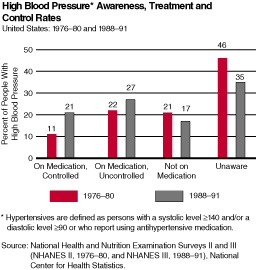 | 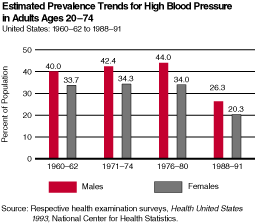 |
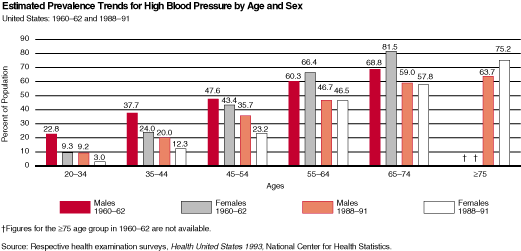 | |
Coronary Disease Risk Factors
- In 1990 about 417,000 Americans died of smoking-related illnesses.
- Nearly one-fifth of deaths from cardiovascular diseases are attributable to smoking. It's also estimated that about 37,000 -- 40,000 nonsmokers die each year from cardiovascular diseases as a result of exposure to environmental tobacco smoke.
- Smoking-related illnesses cost about $50 billion annually in medical care.
- Studies show that among people age 18 and older in the United States, smoking has declined by about 40 percent since 1965, although recent data indicate that this downward trend may have leveled off.
Age, Sex
- Every day 3,000 American young people become smokers, according to estimates by the Centers for Disease Control and Prevention.
- 75 percent of adult smokers started before age 18 and 90 percent began before they were 21, according to Centers for Disease Control and Prevention estimates.
- 43 percent of American children ages two months to 11 years are exposed to environmental tobacco smoke in the home.
- Current estimates are that 26.0 million men (28.2 percent) and 23.1 million women (23.1 percent) in the U.S. are smokers, putting them at increased risk of heart attack. In addition, an estimated 2.2 million adolescents ages 12 -- 17 are smokers.
- The World Health Organization reports that 20 -- 35 percent of women in developed nations smoke compared with 2 -- 10 percent of those in the developing nations.
- Studies show that women smokers who use oral contraceptives are much more likely to have a heart attack and much more likely to have a stroke than women who neither smoke nor use birth control pills.
- Studies show that smoking prevalence is several times higher among those with less than 12 years of education compared to those with more than 16 years of education.
- 47.7 percent of working adults who are 17 years old or older and do not use tobacco reported exposure to environmental tobacco smoke at home or at work.
- Of adults who don't use tobacco, 37.4 percent reported exposure to environmental tobacco smoke at home or at work.
- The risk of death from coronary heart disease increases by up to 30 percent among those exposed to environmental tobacco smoke at home or at work.
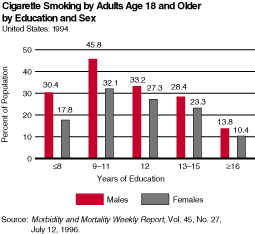 | 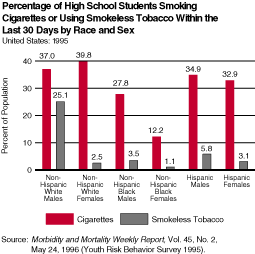 |
An estimated 97.2 million American adults (52.1 percent) have blood cholesterol levels of 200 milligrams per deciliter (mg/dL) and higher, and about 38.3 million American adults (20.5 percent) have levels of 240 mg/dL or above.*
- About 36.5 percent of American youth age 19 and under (27.4 million young people) have blood cholesterol levels of 170 mg/dL or higher. (This is comparable to a level of 200 mg/dL in adults.)
- 13.0 million boys and 14.4 million girls age 19 and under have blood cholesterol levels of 170 mg/dL or higher.
- Studies done on people age 20 and older show that women's cholesterol is higher than men's beginning at age 55.
- Before age 45, the range of means for total blood cholesterol of women is from 185 -- 207 mg/dL, but between ages 45 and 64, the range rises to between 217 and 237 mg/dL.
- Among elderly Japanese-American men in the Honolulu Heart Program Fourth Examination (1991 -- 93), 42 percent had cholesterol levels greater than or equal to 200 mg/dL or were taking cholesterol-lowering medication.
*Centers for Disease Control and National Center for Health Statistics: Unpublished and published data from Phase I, National Health and Nutrition Examination Survey III (NHANES III), 1988 -- 91 and the American Heart Association.
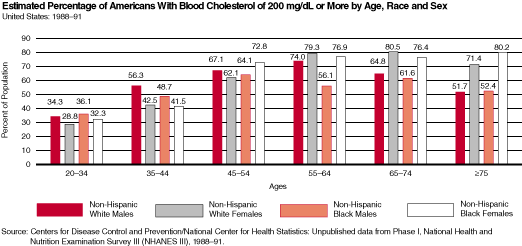 | |
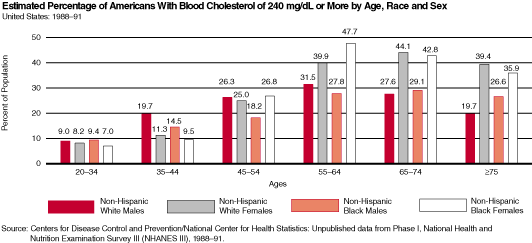 | |
- About 22 percent of American adults report regular sustained physical activity of any intensity lasting 30 minutes or more five times a week.
- About 15 percent of U.S. adults engage in regular vigorous physical activity three times a week for at least 20 minutes.
- About 25 percent of Americans age 18 or older report no leisure-time physical activity.
- 1994 Behavioral Risk Factor Surveillance Survey (BRFSS) state data show that 60 percent or more of adults did not achieve the recommended amount of physical activity, and in half of the states 73 percent or more of adults were not active enough.
- People with lower incomes and less than a 12th grade education are more likely to be sedentary.
- The relative risk of coronary heart disease (heart attack) associated with physical inactivity ranges from 1.5 to 2.4, an increase in risk comparable with that observed for high cholesterol, high blood pressure or cigarette smoking.
- Less active, less fit persons have a 30 -- 50 percent greater risk of developing high blood pressure.
- As many as 250,000 deaths per year in the United States -- about 12 percent of total deaths -- are attributed to a lack of regular physical activity.
<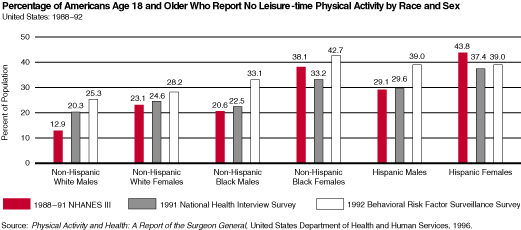 |
Age, Sex
- Nearly half of American youth ages 12 -- 21 are not vigorously active on a regular basis. Physical activity declines dramatically during adolescence.
- Daily enrollment in Physical Education classes has declined among high school students from 42 percent in 1991 to 25 percent in 1995.
- Only 19 percent of all high school students are physically active for 20 minutes or more in physical education classes every day during the school week.
- A 1996 report of physical Activity showed the number of Americans age 18 and older who reported no physical activity was 15.8 percent of men and 27.1 percent of women.
- The percentage of adults ages 65 -- 74 and 75 and older who reported no leisure time physical activity in 1992 was 33.2 percent and 38.2 percent for men and 36.6 percent and 50.5 percent for women, respectively. In 1988 -- 91, it was 17.5 percent and 34.5 percent for men and 32.5 and 54.3 percent for women, respectively.
Based upon 1988 -- 91 data, nearly 62 million American adults (28.1 million men and 33.9 million women) are 20 percent or more above their desirable weight, an increase of 36 percent over 1960 -- 62 examination data.
- 33 percent of overweight men and 41 percent of overweight women are not physically active during their leisure time.
- Data show the prevalence of overweight among American adolescents age 12 to 19 to be 21 percent (20 percent for males and 22 percent for females).
- Among native Hawaiians, 65.5 percent of males and 62.6 percent of females are overweight.
Diabetes killed 55,390 Americans in 1994. 1993 final mortality: males -- 23,430 deaths (43.5 percent of total deaths from diabetes); females -- 30,464 (56.5 percent of total deaths from diabetes).
- 7,800,000 Americans have diabetes (3.6 million males and 4.2 million females).
- 625,000 new cases of diabetes are diagnosed every year.
- 502,000 Americans diagnosed with diabetes mellitus were discharged from hospitals in 1994. Of these, 223,000 were males and 279,000 were females.
- More than 80 percent of people with diabetes mellitus die of some form of heart or blood vessel disease.
- In the 1991 -- 93 phase of the Honolulu Heart Program, 17 percent of Japanese-American men ages 71 -- 93 had diabetes. In addition, 19 percent had unrecognized diabetes and 32 percent had impaired glucose tolerance.
http://www.fauxpress.com/kimball/med/heart/h2/coron.riskf.htm
Coronary Heart Disease and Angina Pectoris
- Heart attack is the single largest killer of males and females in the developed world.
- This year as many as 1,500,000 Americans will have a new or recurrent heart attack, and about one-third of them will die.
- At least 250,000 people a year die of heart attack within one hour of the onset of symptoms and before they reach a hospital. These are sudden deaths caused by cardiac arrest, usually resulting from ventricular fibrillation.
- 13,670,000 people alive today have a history of heart attack, angina pectoris (chest pain) or both. This breaks down to 6,930,000 males and 6,750,000 females.
- Studies show that the risk of death from heart disease is much greater for the least-educated than for the most-educated people.
- From 1984 to 1994, the death rate from heart attack declined 28.6 percent, but the actual number of deaths declined only 9.9 percent.
Age, Gender
- Based on the Framingham Heart Study, five percent of all heart attacks occur in people under age 40, and 45 percent occur in people under age 65.
- 84.6 percent of people who die of heart attack are age 65 or older.
- About 80 percent of coronary heart disease mortality in people under age 65 occurs during the first attack.
- In 48 percent of men and 63 percent of women who died suddenly of coronary heart disease, there were no previous symptoms of this disease.
- 1993 coronary heart disease final mortality: male deaths -- 250,362 (51.1 percent of deaths from coronary heart disease); female deaths -- 239,701 (48.9 percent of deaths from coronary heart disease).
- The Cardiovascular Health Study showed the prevalence of myocardial infarction in older American men was 18.0 percent for ages 65 -- 69 and 29.6 percent for ages 80 -- 84. The prevalence in older women was 9.7 percent for ages 65 -- 69 and 17.9 percent for age 85 and older.
After an Attack
- At older ages, women who have heart attacks are more likely than men to die from them within a few weeks.
- Sudden death occurs at from four to six times the rate of the general population among people who've had a heart attack.
- 27 percent of men and 44 percent of women will die within one year after having a heart attack.
- 1,219,000 males and 899,000 females diagnosed with coronary heart disease were discharged from hospitals in 1994.
Angina Pectoris
Estimates are that 7,120,000 people in the United States have angina pectoris (chest pain). This breaks down to 2,860,000 males and 4,290,000 females. A small number of deaths are coded as being from angina pectoris. These are included as a portion of total deaths from coronary heart disease.
- Based on the Framingham Heart Study, about 350,000 new cases of angina occur each year.
- The estimated prevalence of angina is greater in women than in men.
- About 68,000 males and 84,000 females diagnosed with angina pectoris were discharged from hospitals in 1994.
- The Cardiovascular Health Study showed the prevalence of angina pectoris in older men was 21.1 percent for ages 65 -- 69 and 27.3 percent for ages 80 -- 84. For older women the prevalence was 13.7 percent for ages 65 -- 69 and 24.7 percent for age 85 and over.
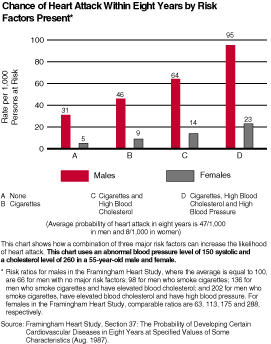 | 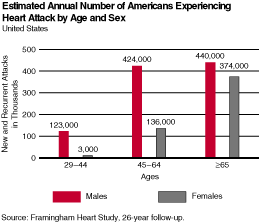 |
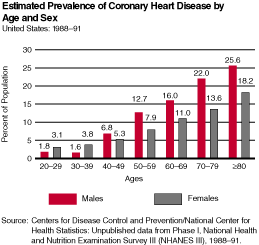 | 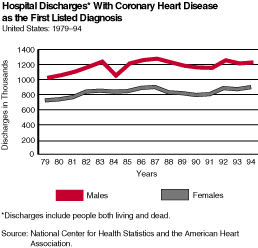 |
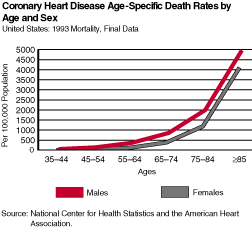 |
Three Myths about CVD
Myth #1:
Basically, it's men who need to worry about CVD, since they have more heart attacks than women.
WOMEN'S DEATHS FROM CARDIOVASCULAR DISEASES (CVD) ARE INCREASING
Leading Causes of Death for Total Females
United States: 1993
CVD = Cardiovascular Diseases
Cardiovascular Disease Mortality Trends for Males and Females, 1979-93

More than one in five women has some form of cardiovascular disease.
Since 1984 the number of cardiovascular disease deaths for women has exceeded those for men. The difference in deaths currently is more than 43,100.
Final 1993 mortality for cardiovascular disease was 500,387 for women compared with 457,211 for men.
In the United States, all cardiovascular diseases claimed the lives of 500,387 females annually while all forms of cancer killed 250,529 females. (Breast cancer claims the lives of about 43,600 females each year; lung cancer claims another 57,600.)
Heart disease no longer represents a serious threat.
CVD IS A MOST SERIOUS THREAT
Medical scientists have made tremendous progress in fighting cardiovascular diseases. Even so, more than 954,000 deaths annually; nearly 42 percent of all deaths every year. In fact, since 1900 the No. 1 killer in the U.S. has been CVD in every year but one (1918).
Deaths don't tell the whole story, either. Of the current U.S. population of about 258 million, more than 57 million people have some form of these diseases. And as the population ages, these diseases may have an even greater human impact. Heart failure, for example, is becoming much more prevalent.
Cancer, AIDS and other diseases deserve research and attention. But it's important to remember that CVD ranks far ahead of them as a cause of death.
Finally, according to the most recent computations, if all forms of major cardiovascular disease were eliminated, life expectancy would rise by almost 10 years. If all forms of cancer were eliminated, the gain would be three years.
If a heart attack doesn't kill you, you'll recover and be fine.
TWO-THIRDS OF HEART ATTACK PATIENTS DON'T FULLY RECOVER
People who survive the acute stage of a heart attack have a chance of illness and death that's two to nine times higher than the general population. The risk of another heart attack, sudden death, angina pectoris, heart failure and stroke -- for both men and women -- is substantial. Within six years after a heart attack, 23 percent of men and 31 percent of women will have another heart attack, 41 percent of men and 34 percent of women will develop angina, about 20 percent will be disabled with heart failure, nine percent of men and 18 percent of women will have a stroke, 13 percent of men and six percent of women will experience sudden death.
About two-thirds of heart attack patients don't make a complete recovery, but 88 percent of those under age 65 are able to return to their usual work.
Bias or Biology?
promote heart disease in men-including smoking, a high- fat diet, and lack of exercise-apply equally to women? Can women derive the same heart benefits from a change in lifestyle?
In trying to answer these questions, one almost immediately stumbles into a gaping void of epidemiologic information pertaining to women's heart disease. Whatever differences there may be in the incidence and development of coronary disease in men and women, the discrepancies in the amount it has been studied in each sex are striking.
Until the last few years, nearly every large-scale study of heart health has excluded women as a matter of policy. The Veterans Administration Cooperative Study, one of the first to document the benefits of coronary surgery for angina; the Multiple Risk Factor Intervention Trial (known,
tellingly, as "Mr. Fit"), which showed that heart attacks could be reduced by eliminating certain risk factors; and the U.S. Physicians Study, which demonstrated that aspirin could help prevent heart attacks-none enrolled a single woman.
The reasons for what now seems a glaring omission? There's no way to measure the role that institutional prejudice, inertia, or gender bias may have played. But one factor that did enter the calculation-as it enters every epidemiologic study-was cost.
"Large-scale studies seek to enroll as many participants as their budgets will allow. Because heart disease is far more common in middle-aged men than in middle-aged women, most early studies, working with limited financial resources, focused on men," says Meir Stampfer, Harvard professor of epidemiology and nutrition. "As a result, researchers missed out on some of the unique features of coronary disease in women."
It is an omission that Stampfer and his colleagues have helped redress through the Nurses' Health Study and Nurses' Health Study II, which have enrolled more than 200,000 women over the past 19 years. The studies have assessed women's heart disease in light of a wide array of variables:smoking, nutrition, physical activity, use of oral contraceptives, and more.
"From all the evidence we've gathered to date, it's fair to say that whatever constitutes a risk factor for coronary disease in one sex is a risk factor in the other sex as well," Stampfer says.
There are a few exceptions--diabetes, for instance, increases women's chances of coronary disease slightly more than it does men's-but, in general, if something is bad-or good-for men's coronary arteries, it will have the same effect on women's arteries. This research has convincingly put the lie to the myth-still flickering in some quarters-that women can smoke and
magically avoid heart disease. "The Nurses' Health Study showed that even low levels of cigarette use-one to four cigarettes a day-doubles a woman's risk of heart attack," he says.
The Nurses' Health Studies also have explored whether there is a link between oral contraceptive use and coronary disease in women. The findings,Stampfer says, ought to be reassuring to some women and alarming to others.
"Women who use oral contraceptives and do not smoke are at no extra risk for coronary disease. Women who smoke and do not use oral contraceptives face a risk of coronary disease three to four times above normal. Women who smoke and use oral contraceptives face 20 to 30 times the risk" That increase, he adds, lasts only as long as women continue to smoke. Kicking the habit
rapidly returns their risk to normal.
The studies of oral contraceptives, while encouraging, need to be updated in light of recent changes in the chemical formulation of birth-control pills, Stampfer adds. "Modern contraceptives are often prescribed at lower doses than the contraceptives of just a few years ago. There has been some suggestion that lower doses may actually confer a protective effect against coronary disease, but there's no documented proof."
http://www.fauxpress.com/kimball/med/heart/Bias.htmlThe Estrogen Factor
The most obvious difference between heart disease rates in men and women-the coronary "grace period" women enjoy prior to menopause-may also be the source of the greatest misunderstanding. Noting the spike in heart disease rates after menopause, researchers have assumed, logically enough, that the dropoff in circulating estrogen levels was responsible.
But logic can be a most unreliable guide to human physiology. Can women indeed thank estrogen for their youthful immunity to heart disease, or is it some chemical component of the hormone that deserves credit?
The case for estrogen is compelling, but not yet complete. Nearly every study done to date-most notably, a Harvard Public Health Study indicates supplemental estrogen protects postmenopausal women against coronary heart disease, but none of these studies was the kind of randomized, controlled trial that is the scientific gold standard. Estrogen is believed to boost a
woman's levels of HDL (the so-called "good" cholesterol) and lower her levels of LDL (the "bad" cholesterol), slowing the process of atherosclerosis. It is also thought to make blood-vessel walls dilate more easily, so blockages are less common.
Among the researchers exploring the artery-friendly powers of estrogen is Frank Sacks, associate professor in the Department of Nutrition. "Estrogen increases the rate at which LDL is removed from the bloodstream," says Sacks. "Our work is focused on the basic, metabolic process by which this happens."
Previous research has found that estrogen increases the number of LDL "receptors" deployed on the surface of liver cells. These receptors, which bind specifically to LDL molecules, enable the liver to filter LDL out of the blood. Sacks has built on this work by showing that estrogen also increases the body's production of HDL, thereby preventing cholesterol buildup in arteries. "A better understanding of this process may one day lead to estrogen-based treatments for lowering high cholesterol counts,"Sacks comments.
Has evolution rigged the heart disease equation against men-endowing women with heart-healthy estrogen and men with testosterone, which has been shown to lower levels of beneficial HDL. "Heart disease was irrelevant in evolution," Sacks remarks. "Few people lived long enough to be affected by it. Testosterone helps build muscles; the fact that it could promote heart disease later in life didn't matter much." Estrogen, on the other hand, "plays a beneficial role during pregnancy by stimulating fat metabolism and helping women put on weight."
http://www.fauxpress.com/kimball/med/heart/Estrogen.html
Women and Heart Disease
If K.'s story conjures the image of a nicotine-stained, slightly paunchy businessman suffering a heart attack, think again. The stereotyped candidate for heart attack may be overweight, overachieving, under-exercised,hypertensive-and resoundingly male-but the fact is coronary heart disease is no more a "man's disease" than is the flu.
Of the one million Americans with the disease, virtually half are women. Of the half-million fatal heart attacks in the United States every year,247,000 occur in women. Among the fortunate survivors of heart attack is K.--for Katherine--a Boston suburbanite now doing well after her mild heart attack in 1993.
Coronary heart disease is the number one cause of premature death-in men and women-in the industrialized world. Women are six times more likely to die of a heart attack than of breast cancer. And women who have a heart attack are twice as likely to die within a few weeks as men who experience a similar attack.
Whence, then, the notion that coronary heart disease is a problem that only men need worry about? Blame it partly on biology: statistics show that heart attacks in women before the age of menopause are rare. A 40 year-old woman has only about one-fourth the chance of dying from heart disease of a man the same age.
But there are other reasons for the misconception. Inadvertently, perhaps, it has been reinforced by researchers who have studied coronary artery disease and doctors who have treated it. Until recently, nearly all epidemiologic studies of coronary disease-what causes it, how it can be treated, and how it can be prevented-have been performed on men. And there is abundant evidence, some scientific, some anecdotal, that physicians have treated coronary disease less aggressively in women than in men.
Whatever the roots of this bias, it has left many women with a false sense of safety-one that could imperil their lives. "Traditionally, women have not believed they would get heart disease, so they haven't sought treatment as aggressively as men have," says Elizabeth Ross, a cardiologist and head of the committee on women and heart disease at the Washington, D.C., chapter of the American Heart Association (AHA). "A man may be playing racquetball and feel a pain in his chest and think right away that it's a heart attack. A woman may experience chest pain and dismiss it as indigestion and not seek prompt treatment."
Such delays can be catastrophic. Modern blood-thinning drugs used to treat heart-attack victims are most effective if administered within four hours of the onset of symptoms. A woman who dismisses the symptoms of a heart attack as stomach trouble, who lies down and tries to "sleep it off" before seeking treatment can do irreparable, possibly fatal, damage to the heart.
Recently, however, women's heart disease has begun to emerge from its public eclipse. A massive public-information campaign by the AHA has spread the word that older women are just-or nearly-as likely to develop coronary disease as men are. And physicians are becoming more attuned to signs of the disease in their female patients. "There has been a definite consciousness-raising about this issue," Ross says. "The prevalence of heart disease in older women, combined with the fact that women tend to live longer than men, mean that women's heart disease is going to be a public health issue for a long time to come."
Hardening Arteries
Despite the underlying similarities, there are important differences in the symptoms that prompt men and women to seek medical attention for coronary problems. The Framingham Heart Study, an ongoing longitudinal study that is one of the few to examine disease rates in both women and men, found that men are more likely to "present" to a physician with a full-blown myocardial infarction, whereas women tend to present with chest pain. When men do present with chest pain, however, it is apt to be the sort of pain classically associated with heart attacks: a sharp pain beneath the breastbone, radiating across the chest. The type of pain that women tend to describe is more diffuse, may be localized in the neck or left arm, and may be confused with nausea.
"Women need to understand that some of their complaints-pains that they may attribute to a gastrointestinal problem-are the equivalent of the substernal [beneath-the-breastbone] pains that men experience," says Elsa-Grace Giardina, professor of medicine at Columbia University's College of Physicians and Surgeons.
Paralleling these differences in presentation are documented differences in the way men and women are treated for coronary disease. In a landmark study published in 1991, Arnold Epstein, associate professor of health care policy at the School, and his colleagues found that women who are hospitalized for coronary heart disease undergo significantly fewer major diagnostic and therapeutic procedures than men.
"We analyzed data on more than 80,000 patients who had been hospitalized in Massachusetts and Maryland for coronary disease and determined how many had received an angiography [a diagnostic procedure in which radioactive dye is injected into the coronary arteries] or coronary-artery bypass surgery," says Epstein, who is also associate professor of medicine at Harvard Medical School. "We found that the odds of receiving an angiography were 28 percent and 15 percent higher for men than for women in Massachusetts and Maryland, respectively. For bypass surgery, the odds were 45 percent and 27 percent higher, in favor of men," Epstein says.
Whether there are sound medical reasons for this disparity, or whether they reflect a pattern of discrimination, is unknown. Doctors also are unsure whether the disparity actually works to women's detriment.
"It's possible that we're treating women appropriately and overtreating men," says Epstein. "Alternatively, differences in treatment may reflect differing preferences for care. Perhaps women are more willing to make lifestyle changes-such as eating better and exercising more-so they can avoid surgery."
To answer these questions, Epstein has embarked on a multi-year, multimillion dollar study that will study patterns of care in more than 5,000 patients across the country. "We're trying to discover what the differences in procedure use between women and men mean in terms of quality and appropriateness of care," says Epstein. "Are women getting too few procedures? Are men getting too many?"
There is a suspicion among some experts in women's health that disparities in treatment of heart disease are less a reflection of hidebound sexism than of ageism. Heart disease generally strikes women later in life than it does men, and "diseases that appear in old age may get less attention," says Marcia Angell, executive editor of the New England Journal of Medicine.
Giardina concurs: "There's a great sense of urgency when a 45-year-old man, who's at the peak of his earning power and may have children entering college, is struck down prematurely with a myocardial infarction. But that sense of urgency may not be as acute if the patient is a 65- or 70-year-old woman."
Still, a female coronary patient presents doctors with a rather different set of variables than a male patient does. For one, women's coronary arteries tend to be smaller than men's, making bypass surgery more difficult and risky. (Fortunately, new techniques have begun to improve surgical outcomes for women.) For another, older patients-male or female-are apt to have other health problems that complicate treating them for heart diseases. They may be diabetic or have high blood pressure. They may have impaired kidney function or respiratory problems or any of a host of "co-morbidities" that make treatment for heart disease even dicier.
"Patients with untreated high blood pressure, for example, usually cannot be given the clot-dissolving medication that heart-attack patients receive, because it could increase the chance of stroke," Giardina remarks.
Use of Aspirins to Treat Heart Attacks
This new use of the drug is based on studies showing that taking as little as half a regular-strength aspirin tablet as soon as a heart attack is suspected and continuing the drug for 30 days can significantly reduce the risk of death, experts said.
Dr. Debra Bowen, director of the drug agency's division for over-the-counter drug products, noted that no one should use the drug for this new indication without consulting a doctor.
A group of cardiac specialists, led by Dr. Charles H. Hennekens of Harvard Medical School, has argued that there is strong evidence from several international studies that aspirin could be beneficial while a heart attack is in progress.
http://www.fauxpress.com/kimball/med/heart/aspirin.html
Studies show that aspirin, which is widely available and costs very little, is as effective as specialized drugs that dissolve the blood clots that cause a heart attack and the other drugs that cost hundreds of dollars per dose.
A major international study of heart attacks that involved more than 17,000 patients at 417 hospitals around the world found that aspirin reduced deaths from heart attack by 23 percent in patients who took the drug within 24 hours of the onset of symptoms. And when aspirin was combined with specialized drugs during this early treatment period, deaths decreased by 42 percent.
Since about 50,000 heart attack patients who are hospitalized in the US die from the condition, general use of aspirin within the first hours of the attack could prevent 5,000 to 10,000 premature deaths each year, said Hennekens, who is chief of preventive medicine at Brigham and Women's Hospital in Boston.
Aspirin works against heart attacks by helping to dissolve clots of blood that block arteries and by preventing further blockages. The drug interferes with the production of substances called prostaglandins, which promote the clumping of blood cells called platelets. These cells are essential to the formation of blood clots.
Affects of Smoking
Smoking cigarettes is like putting your blood vessels into a time machine headed into the future. As people age, the walls of their arteries gradually thicken. Research published in the AHA journal Circulation shows that cigarette smoking accelerates this process by more than a decade. By adding the equivalent of 10 years of aging to their arteries, smokers are increasing their risk of stroke and heart attack. Grethe S. Tell, Ph.D.,M.P.H., professor of epidemiology at Bowman Gray School of Medicine in Winton-Salem, N.C., and her colleagues, analyzed data from ultrasound exams of the carotid arteries of 5,116 people older than 64.
They found "clinically significant" (50 percent or more of the artery's width) narrowing of these major blood vessels in 4.4 percent of people who had never smoked, 7.3 percent of former smokers and 9.5 percent of current smokers. Ultrasound imaging is a non-invasive technique that uses high frequency sound waves to help produce images of the body's interior. Located in the neck, the carotid arteries carry blood to the brain. If narrowed by atherosclerosis--a condition of arteries characterized by deposits of fat, cholesterol and other substances--a stroke may result.
The carotids are important and very easy to examine with ultrasound, Tell says. "We know that what we find in the carotids is a reflection of what's happening elsewhere in the body." "The difference in internal carotid wall thickness between current smokers and nonsmokers was greater than the difference associated with 10 years of age among never- smoking participants," the scientists wrote in their report. Until now there have been some doubts as to whether smoking is harmful in older people, Tell says. "But we found smoking has bad effects even among the elderly. People who continue to smoke in old age have more clogged arteries than people who don't." The men and women who participated in this study were selected from Medicare eligibility lists from Allegheny County (Pittsburgh), Pa; Forsyth County, N.C.; Sacramento County, Calif.; and Washington County, Md.
The scientists say there is "abundant evidence" that cigarette smoking causes atherosclerosis. Cigarette smoking is firmly established as a risk factor for coronary heart disease, peripheral vascular disease and stroke, Tell and her associates note. Their study, which is part of the Cardiovascular Health Study, is designed to determine if asymptomatic disease detected with ultrasound progresses less in people who quit smoking.
http://www.fauxpress.com/kimball/med/heart/smoking.html
Long-distance runners double "dilating" capacity of their coronary arteries
"This study is unique in that it provides the first evidence in living humans that prolonged endurance training may substantially affect coronary artery anatomy and physiology," says an editorial accompanying the new study. The research report and editorial are published in the American Heart Association's scientific journal Circulation.
Eleven men who underwent vigorous aerobic exercise training demonstrated a dilating capacity of their coronary arteries that was about twice as great as that of a group of 11 sedentary men, reports William L. Haskell, Ph.D., lead author of the study and professor of medicine at Stanford University School of Medicine, Palo Alto, Calif.
The 11 middle-aged runners in the study trained about 50 miles per week for an average of 13 years and during the past two years had participated in "ultradistance" running. All 11 had run the Western States 100-Mile Trail Run, an ultramarathon race from Squaw Valley, Calif. to Auburn, Calif. over some mountain trails, the scientists say. Among the group of 11, their average best time for running a 100-mile race was 19 hours and 55 minutes.
What about lesser mortals who run for only 30 to 60 minutes, at least three times a week, as the AHA recommends? Will that level of exercise improve the coronary arteries' dilating capacity?
"We don't know how much of a change in coronary artery dilating capacity is achievable with lower levels of exercise," says Haskell, an exercise physiologist. "So this study is really just a first step."
http://www.fauxpress.com/kimball/med/heart/running.htmlPrevalence of Adults With No Known Major Risk Factors for Heart Disease
Although the death rate for coronary heart disease (CHD) in the United States has declined approximately 50% since 1970, CHD remains the leading cause of death for both men and women and, in 1990, accounted for 489,340 deaths (1). National strategies and programs have targeted individual risk factors for death attributed to CHD. However, an alternative approach may be to measure the prevalence of adults who have no known risk factors for CHD.
This report provides state-specific estimates of and characterizes adults who report having no known major risk factors for CHD.
Data were analyzed from 91,428 persons aged greater than or equal to 18 years who resided in 48 states and the District of Columbia and participated in the 1992 Behavioral Risk Factor Surveillance System (BRFSS), a random-digit-dialed telephone survey. The analysis examined survey responses regarding the following risk factors: current cigarette smoking (smoked at
least 100 cigarettes in their lifetime and now smoking), physical inactivity (no or irregular leisure-time physical activity), overweight (body mass index greater than or equal to 27.3 for women and greater than or equal to 27.8 for men), high blood pressure (told more than once by a health professional he/she has high blood pressure or is currently taking antihypertensive medications),high blood cholesterol (ever told by a health professional he/she has high blood cholesterol), and diabetes (ever told by a doctor he/she has diabetes).
Persons who reported having none of these risk factors were defined as having no known risk factors for CHD.
The results were weighted to account for the distribution of demographic characteristics in each state. To determine the actual prevalence of adults in each state with no known CHD risk factors, state-specific estimates were not standardized to a referent population. For data aggregated from all states,census data for the 1980 U.S. population were used to standardize comparisons
by age, race, and educational status; aggregated analyses were restricted to black and white respondents for whom the age, race, and education distributions of the population were known. SESUDAAN was used to calculate the standard errors for the prevalence estimates (2).
Of the 91,428 respondents, 18% reported having none of the six major CHD risk factors; 35% reported having one risk factor; 29%, two risk factors; 13%,three risk factors; and 5%, four to six risk factors. In every state, less than 30% of the population had no known risk factors. The state specific proportion of respondents with no known risk factors varied minimally; in 45 (92%) of the states, the proportion ranged from 14% to 26% (Table 1).
For both males and females, the percentage of respondents with no known risk factors was highest for 18-34-year-olds. Among males, the percentage was lowest for those aged 50-64 years, and among females, the percentage varied inversely with age (Table 2). The prevalence of no known risk factors for CHD increased directly with increasing level of education.
Results
The finding in this report that, in 1992, only 18% of adults reported having no known risk factors for CHD indicates that, despite improvements in the treatment and control of CHD-related conditions, a substantial percentage of adults continue to be at risk for CHD. This low prevalence underscores the need for primary prevention efforts that focus on achieving behavioral changes that prevent the occurrence of risk factors.
Several of the year 2000 national health objectives target the primary prevention of specific risk factors for CHD, including overweight (objective 15.10), physical inactivity (objective 15.11), high blood cholesterol (objective 15.7), and cigarette smoking (objective 15.12) (3).
Achievement of these objectives should increase the number of U.S. adults who have no known major risk factors for CHD and further reduce CHD- associated mortality.
The prevalences of two risk factors--cigarette smoking and high blood cholesterol--have decreased substantially. In 1965, approximately 40% of U.S.
adults smoked cigarettes; in comparison, by 1991, 26% smoked cigarettes (4). In addition, from the second National Health and Nutrition Examination Survey (NHANES II) (1976-1980) to NHANES III (1988-1991), the proportion of adults with high blood cholesterol levels (greater than or equal to 240 mg/dL) decreased from 26% to 20% (5). For other risk factors, however, prevalences have remained constant or increased. For example, when compared with 1987, the
proportion of adults who engaged in no leisure-time physical activity (24%) in 1991 was unchanged, and the proportion who engaged in moderate physical activity five or more times per week increased only slightly (22% in 1987 and 24% in 1991) (6). From 1987 through 1991, the proportion of U.S. adults who were overweight increased from 26% to 28%, respectively (6). Finally, despite substantial improvements in the awareness, treatment, and control of hypertension, hypertension continues to affect an estimated 50 million persons in the United States (7).
Although the findings in this report assist in targeting efforts to reduce specific risk factors for CHD, these findings are subject to at least two limitations. First, because BRFSS estimates are based on self reports, the prevalence of most risk factors, especially overweight and current smoking status, are likely to be underreported. Second, risk factors for which awareness is low are underreported; for example, only an estimated 29% of adults know their cholesterol level (8). Therefore, this report most likely overestimates the proportion of adults without CHD risk factors.
For example, the National High Blood Pressure Education Program has developed policy recommendations for implementing primary prevention interventions for hypertension (9), and the National Cholesterol Education Program has made dietary recommendations to reduce cholesterol levels (10). The need for the primary prevention of CHD risk factors also is important because education or treatment of persons with established risk factors may not reduce their risk to the level of persons who never have the risk factor; for example, persons who effectively control their hypertension remain at higher risk for CHD than do persons who never develop hypertension (9).
1. American Heart Association. 1993 Heart and stroke facts statistics. Dallas:American Heart Association, 1992.
2. Shah BV. SESUDAAN: standard errors program for computing of standardized rates from sample survey data. Research Triangle Park, North Carolina:Research Triangle Institute, 1981.
3. Public Health Service. Healthy people 2000: national health promotion and disease prevention objectives--full report, with commentary. Washington, DC:US Department of Health and Human Services, Public Health Service, 1991; DHHS publication no. (PHS)91-50212.
4. CDC. Cigarette smoking among adults--United States, 1991. MMWR 1993;42:230-233.
5. Sempos CT, Cleeman JI, Carroll MD, et al. Prevalence of high blood cholesterol among US adults: an update based on guidelines from the second report of the National Cholesterol Education Program Adult Treatment Panel.JAMA 1993;269:3009-14.
6. CDC. Health, United States, 1992, and healthy people 2000 review.Hyattsville, Maryland: US Department of Health and Human Services, Public Health Service, 1993; DHHS publication no. (PHS)93-1232.
7. Joint National Committee on Detection, Evaluation, and Treatment of High Blood Pressure. The fifth report of the Joint National Committee on Detection,Evaluation, and Treatment of High Blood Pressure (JNC V). Arch Intern Med 1993;153:154-83.
8. CDC. Cholesterol screening and awareness--Behavioral Risk Factor Surveillance System, 1990. MMWR 1992;41:669,675-8.
9. National High Blood Pressure Education Program Working Group. National High Blood Pressure Education Program Working Group report on primary prevention of hypertension. Arch Intern Med 1993;153:186-208.
10. Expert Panel on Detection, Evaluation, and Treatment of High Blood Cholesterol in Adults. Summary of the second report of the National Cholesterol Education Program (NCEP) Expert Panel on Detection, Evaluation,and Treatment of High Blood Cholesterol in Adults (Adult Treatment Panel II).JAMA 1993;269:3015-23.
Cardiovascular Health Studies Br, Div of Chronic Disease Control and Community Intervention, National Center for Chronic Disease Prevention and HealthPromotion, CDC.
http://www.fauxpress.com/kimball/med/heart/norisk.html